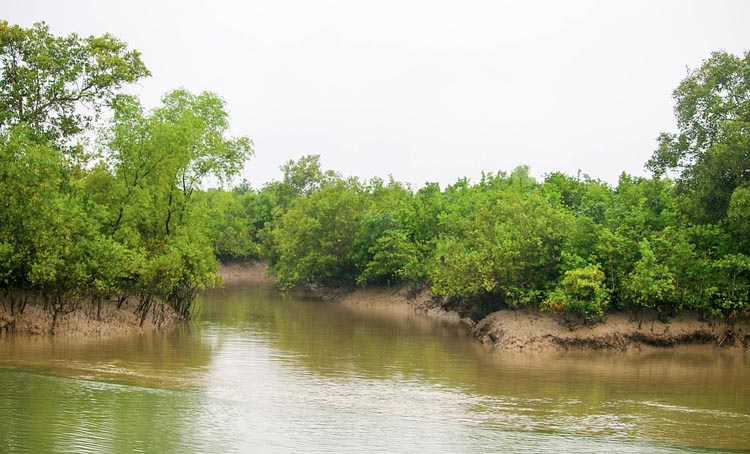News Flash
News Flash

KHULNA, Jan 26, 2025 (BSS) - Sunderbans, the largest mangrove forest in the world, is famous for its mangrove surroundings including all the creeks and rivers.
The main attraction or the spotlights of aquatic species in Sundarbans are
mudskipper fishes like Periophthalmus and Boleophthalmus.
Besides, the larger terrestrial mammals are Royal Bengal Tiger, spotted deer,
Rhesus macaque and Indian smooth otter. The giant salt-water crocodiles, Rock
Python, Monitor lizards and king cobra are the prominent species of the
reptile group.
Referring to various research findings, Prof Abdullah Harun Chowdhury of the
Environmental Science Discipline at Khulna University, said the forest is a
cluster of Islands, the single largest chunks of productive mangrove forest
in the world and the world heritage site.
The Bangladesh part of Sundarbans Reserved Forest covers 6,017 kilometers of
areas in the Southwest corner of Bangladesh.
There are 333 species of plant, 400 species of fishes, 270 species of local
birds and another 45 species of migratory birds, 35 species of amphibians and
42 species of mammals in the largest mangrove contains.
Prof Harun Chowdhury attributed that the forest is dense and continuous and
the forest vegetation is evergreen which grows chiefly on muddy sheltered
shores of coastal areas subject to the periodic submergence by tidal waters.
The characteristic of Sunderban forest is a low-lying tidal riparian forest
intersected by an elaborate network of rivers, canals and creeks. The forest
is accessible only by boat during the whole of the year.
The forest has gained two naturalists attraction from all over the world for
her magnificent reservoir of genetic biodiversity and the majestic Royal
Bengal Tiger of Sundarbans forest, the priceless heritage of mankind.
Talking to BSS, Shubhra Shachin, Chief Executive of Sundarbans and Upakul
Suraksha Foundation, said the tiger being the most attractive wild animal is
now an internationally endangered species of which the Sundarbans contain the
largest surviving tiger population.
Although tiger is seldom rare to see, the probability of seeing tiger in
Sundarbans forest is low-lying tidal riparian forest intersected by an
elaborate network of river, canals and creeks.
So, the journey to this wonderful jungle will be very much rewarding to know
the unknown. This unsurpassed jungle is only accessible by boat.
However, the Sundarbans is under severe pressure and its protective function
is rapidly being undermined by poaching, illegal logging and other means of
unsustainable resource extraction.
Prof Anwarul Kadir, Executive Director of Sundarbans Academy, told BSS that
wildlife trafficking, overfishing and fishing with poison have escalated the
threat to wildlife, putting the biodiversity of the largest mangrove forest
in the world at risk
Climate change poses a threat to the Sundarbans region, home to millions of
marginalized people and shelter for millions of animals.
The threat to wildlife has grown due to river pollution from ships and
industrial wastes, as well as the salinization of the water. Due to hunting
and trafficking, tigers in the Sundarbans are at risk of extinction.
Climate change and sea level rise have negative impacts as well: high tides
are penetrating further inland each year, causing top-dying of the Sundari
trees which are said to be intolerant to increased salinity
Quoting a survey report in 2024, Mihir Kumar Doe, Conservator of Forest (CF),
told BSS that there are 125 tigers in the forest, while the number was 118 in
2018.
"We are implementing a project titled "Tiger Conservation in Sundarbans"
since April 2022 for tiger survey through camera trapping and survey of tiger
prey animals," he added.
Various other works, including construction of 60-kilometer fencing adjacent
to the localities to reduce tiger-people conflicts, construction of highlands
for sheltering tiger and other wild animals during the time of cyclone and
other natural disasters and research on tigers, are being implemented under
the Taka 35.93 crore project.
"We are also working for ecosystem conservation of the forest and
conservation of its wildlife and biodiversity along with protecting the
forest from the adverse impact of climate change," Mihir Kumar said.
The Taka 157.87-crore project titled "Conservation of Sundarbans" has also
provision of reducing tiger-people conflicts, controlling offense related to
forest and wildlife, science-based forest management infrastructural
improvement and inclusion of forestry for creating green belt in the coastal
areas.
Mihir Kumar said that a feasibility study is also being conducted to build a
world-class tourism facility near Sundarbans, keeping its ecosystem intact to
make the mangrove forest as one of the attractive tourist destinations.
Referring to its enormous aspects he said Sundarbans is seeing a sharp rise
in number of tourists, prompting the authorities to set up more four eco-
tourism centres in Alibanda, Andamanik, Shekhertek and Kalabagi.